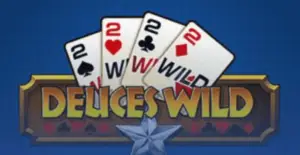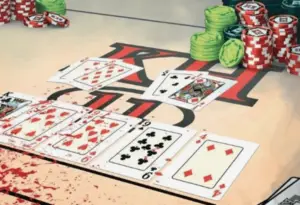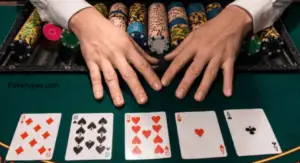Bankroll management in poker is the cornerstone of long-term success at the tables. It refers to the strategic rules players implement to protect their poker funds and ensure they don’t go broke.
For example, if you have a $1,000 bankroll, proper management might dictate only playing in $5 tournaments or lower to maintain approximately 200 buy-ins. This fundamental concept separates successful players from those who bust out, regardless of skill level.
The three key principles include only risking money you can afford to lose, playing at appropriate stakes for your skill level, and maintaining strict discipline in bankroll growth.
Think of your poker bankroll like a business investment – you wouldn’t risk your entire company’s capital on one venture, and similarly, you shouldn’t risk too much of your poker funds on any single session.
Even the most skilled players can face significant downswings due to variance, making proper bankroll management essential for surviving the inevitable ups and downs of the game.
How to Build Your Initial Poker Bankroll?
Building a solid poker bankroll requires careful planning and disciplined execution. Here’s how to establish and grow your initial poker funds:
Determining Your Starting Bankroll
For cash games, you should start with at least 50 buy-ins at your chosen stake level.
For example, if you plan to play $0.01/$0.02 (NL2), you’ll need a minimum bankroll of $100 since the maximum buy-in is typically 100 big blinds ($2). For tournament players, the recommended starting bankroll is 100 buy-ins for your chosen tournament level.
Building From Scratch
Starting from zero is possible through several proven methods: Freeroll Tournaments offer an excellent opportunity to build a bankroll without risking any money. Many online poker sites run daily freerolls with real money prizes.
For example, Chris Ferguson famously built a bankroll from $0 to $10,000 over 18 months, spending nine months grinding freerolls to reach his first $100.Micro-Stakes Games provide a practical pathway for growth. Begin at the lowest stakes available:
- $0.01/$0.02: Requires $100 bankroll
- $0.02/$0.05: Requires $250 bankroll
- $0.05/$0.10: Requires $500 bankroll
Separating Poker and Personal Finances
Creating a clear division between poker and personal funds is crucial for long-term success. Professional players recommend:
Opening a separate bank account specifically for poker funds
Maintaining an emergency fund outside your poker bankroll
Setting up automatic transfers for a regular “poker paycheck”
For example, if your monthly expenses are $5,000, you might transfer $2,500 on the 1st and 15th of each month from your poker account to your personal account.
Any excess winnings should be kept in your poker bankroll until you reach the required amount for the next stake level. Bankroll Growth Strategy:
Start with the minimum required for your chosen stake
Move up only when you have the full recommended bankroll for the next level
Drop down a level if your bankroll falls below 40% of the recommended amount
Remember to utilize poker site bonuses and loyalty programs to boost your initial bankroll. Major sites like PokerStars offer up to 65% rakeback, while PartyPoker provides up to 60% cashback to players. These rewards can significantly impact your bottom line, especially when starting out.
Bankroll Requirements for Different Poker Formats
Managing your bankroll depends on what poker variant you’re playing because different poker variants require different bankrolls. Now let’s take a look at the bankroll requirements for a few popular poker variants:
Cash Game Requirements
No-Limit Hold’em
For No-Limit Hold’em cash games, your bankroll requirements vary based on table format:
- 6-max tables: Require 50-75 buy-ins for online play
- Full ring tables: Need 40-60 buy-ins due to lower variance
For example, if you’re playing $0.50/$1 NLHE, you’ll need:
- 6-max: $5,000-$7,500 bankroll (100BB buy-ins)
- Full ring: $4,000-$6,000 bankroll
Pot-Limit Omaha
PLO demands larger bankrolls due to higher variance:
- Minimum 100 buy-ins for regular stakes
- 150 buy-ins recommended for professional play
For a $1/$2 PLO game, maintain a bankroll of $20,000-$30,000 to handle the swings.
Tournament Requirements
Multi-Table Tournaments (MTTs)
MTT players need substantial bankrolls due to high variance:
- 200-300 buy-ins for regular tournaments
- 300-500 buy-ins for large field events
Example bankroll requirements for MTTs:
- $5 tournaments: $1,000-$1,500
- $10 tournaments: $2,000-$3,000
- $25 tournaments: $5,000-$7,500
Sit & Go Tournaments
SNG requirements are lower due to smaller field sizes:
- Regular 9-player SNGs: 50 buy-ins
- Turbo SNGs: 75 buy-ins
- Hyper-turbo: 100 buy-ins
For a $10 SNG player, maintain:
- Regular: $500 bankroll
- Turbo: $750 bankroll
- Hyper: $1,000 bankroll
Heads-Up Tournaments
Heads-up formats require smaller bankrolls:
- 20-40 buy-ins for regular speed
- 30-50 buy-ins for turbo formats
Adjusting Requirements
Skill Level Considerations
Adjust your bankroll based on your win rate:
- 3BB/100: Need 100 buy-ins
- 7BB/100: Can manage with 60 buy-ins
- 20BB/100: May only need 25 buy-ins
Variance Factors
Consider these factors when adjusting requirements:
Playing style: Aggressive players need larger bankrolls
Game type: Higher stakes require more conservative management
Reload ability: Having external income allows for smaller bankrolls
Professional vs Recreational
Professional players should maintain larger bankrolls:
Pros: 100+ buy-ins recommended
Recreational players: Can manage with 30-50 buy-ins
Semi-pros: 50-75 buy-ins suggested
Remember to adjust these requirements based on your personal circumstances and risk tolerance. Moving up or down in stakes should be done gradually, typically when reaching 125% of the required bankroll for your current level
How to Implement Effective Bankroll Management Strategies?
Now that we have discussed the strategies above, it is time to put them into practice. You’ve got to practice because the more you play, the better you’ll be at managing your bankroll.
Setting Stop-Loss Limits
Implementing strict stop-loss limits is crucial for protecting your bankroll. Set a maximum loss of 2-3 buy-ins for cash games or 5% of your total bankroll for any single session.
For example, with a $1,000 bankroll, never lose more than$50in one session, regardless of how well you think you’re playing.
Moving Through Stakes
Smart stake progression follows these guidelines:
- Move up when reaching 125% of the required bankroll
- Move down if falling to 75% of the required bankroll
- Never skip levels when moving up
For instance, if playing $0.25/$0.50, wait until your bankroll reaches $3,750 before moving to $0.50/$1.00 games.
Managing Downswings
During inevitable downswings, follow these strategies:
- Drop down in stakes immediately if losing 20% of your bankroll
- Take a short break after losing 2 buy-ins
- Review your play using tracking software
- Focus on making +EV decisions rather than results
Tracking Results
Use poker tracking software to monitor your progress:
- Record every session’s results
- Track key metrics like BB/100 and ROI
- Analyze your win rates by:
- Position
- Game type
- Time of day
- Session length
For example, Poker Analytics or PokerTracker can help identify that you’re more profitable:
- Playing 6-max vs. full ring
- During evening hours vs. late night
- In 2-hour sessions vs. longer sessions
Remember to review your tracking data monthly to identify leaks and adjust your strategy accordingly. Professional players recommend spending at least 1 hour reviewing for every 4 hours played to maintain a winning trajectory.
Advanced Bankroll Management Concepts
Next, we’ll talk about how to manage your bankroll like a pro.
Shot-Taking Strategy
Professional players recommend taking calculated shots at higher stakes when you have at least 125% of your current stake’s recommended bankroll.
For example, if you’re playing NL200 with a $10,000 bankroll, consider taking shots at NL500 when your roll reaches $12,500.However, maintain strict stop-loss limits of 2-3 buy-ins per session when shot-taking.
Professional Bankroll Requirements
Full-time players should maintain larger bankrolls than recreational players:
- Cash Games: 100+ buy-ins
- Tournaments: 300+ buy-ins
- High Stakes: Consider selling action or swapping percentages
For instance, a $2/5 NL player should have at least $50,000 in their bankroll to properly manage variance.
ROI-Based Adjustments
Adjust your bankroll requirements based on your win rate:
- 3BB/100: Need 100 buy-ins
- 7BB/100: Can manage with 60 buy-ins
- 20BB/100: May operate with 25 buy-in
Professional players like Daniel Negreanu emphasize the importance of having a substantial buffer. He shares a cautionary tale of risking his entire $30,000 bankroll in a high-stakes game early in his career – a mistake he advises others to avoid.
Profit Management
Successful players typically follow the50-50 rule:
- Keep 50% of profits in bankroll
- Withdraw 50% of living expenses
- Only withdraw when bankroll exceeds 45-60 buy-ins
This approach ensures sustainable growth while maintaining professional stability. For example, with monthly profits of $2,000, allocate $1,000 to bankroll growth and $1,000 for personal use.
Common Bankroll Management Pitfalls and How to Avoid Them
1. Playing Outside Your Bankroll
The most common pitfall in poker is playing stakes too high for your bankroll. For example, jumping from $0.25/$0.50 to $2/$5 just because you won a few sessions can quickly lead to disaster. Professional players recommend never risking more than 5% of your total bankroll in any single session.
Variance Adjustment Failures
Many players fail to account for downswings properly. Even skilled players can experience losing streaks of 20-30 buy-ins. The solution is to move down in stakes when your bankroll drops below 75% of the recommended amount for your current level.
For instance, if you’re playing $1/$2 with a $10,000 bankroll, move down to$0.50/$1if your bankroll falls below $7,500.
Emotional Decision Making
Tilt remains one of the biggest bankroll killers. Common triggers include:
Losing several big pots in a row
Bad beats in crucial situations
Running below the expected value
To combat tilt, implement these strategies:
Set a stop-loss limit of 2-3 buy-ins per session
Take a mandatory break after losing two buy-ins
Use tracking software to maintain objectivity
Professional player Doug Polk demonstrated these pitfalls during his bankroll challenge when he lost 75% of his roll in one session by playing outside his limits.
This shows that even the best players aren’t immune to these common mistakes, making strict adherence to bankroll management principles essential for long-term success.
Tools and Resources for Poker Bankroll Management
Modern poker players have access to powerful tools for managing their bankrolls effectively. Poker tracking software like PokerTracker and Holdem Manager help players monitor their win rates and analyze their play across different stakes and formats.
For example, these tools can show that you’re winning 7BB/100 at NL25 but only 2BB/100 at NL50, helping you make informed decisions about moving up in stakes.
Bankroll management apps like Poker Stack offer free tracking with visual graphs and statistics to monitor your progress. For more advanced analysis, variance calculators help simulate potential downswings – showing that even a 20BB/100 winner needs at least 25 buy-ins to handle normal variance.
Many players also benefit from educational resources like LearnWPT and Upswing Poker, which offer comprehensive courses on bankroll management taught by professionals.
These platforms provide GTO solvers and over 500 strategy episodes to help improve your game while maintaining proper bankroll discipline.
The combination of tracking tools, simulators, and coaching resources creates a powerful framework for sustainable bankroll growth.
Conclusion
Proper bankroll management serves as the foundation for long-term poker success. By maintaining adequate buy-ins (50-100 for cash games, 200-300 for tournaments), setting strict stop-loss limits, and moving through stakes responsibly, you protect yourself from the inevitable swings of the game.
Professional players like Daniel Negreanu and Phil Ivey credit their success to disciplined bankroll management, proving that even the most skilled players need this safety net.
Remember, poker is a long-term game where survival is key – with proper bankroll management, you give yourself the best chance to grow from a $100 micro-stakes player to potentially competing in high-stakes games worth thousands of dollars.























































